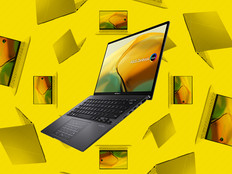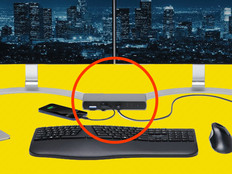Rugged Appeal
Tough enough to thrive in the harshest environments, rugged notebooks are on the job in public-safety applications.
It’s high noon on a summer day in Beaumont, Texas. Jefferson County Sheriff’s Deputy William Eichelberger gets a call from dispatch about a burglary in west Jefferson County. He jumps into his cruiser parked outside. The sun has baked the interior to 125 degrees, so it takes a few seconds with the A/C running full blast to make the car temperature bearable.
Meanwhile, despite the heat, the General Dynamics-Itronix XR-1 rugged notebook computer mounted in the vehicle is ready to go, with the call information and address already loaded. Deputy Eichelberger, also known as Ike, drives to the scene and starts the investigation. After interviewing the homeowner, he returns to his car, where he types the burglary offense report into the notebook. Since the homeowner was able to give a decent description of the intruder, the deputy pulls up mug shots of the possible suspect. Deputy Eichelberger checks the identified suspect’s last known address and speeds away to continue his investigation.
While the exact details of this scenario are hypothetical, this picture is a far cry from the way the deputies in Jefferson County, Texas, used to do business. Before the Jefferson County Sheriff’s Office installed rugged notebooks in its cruisers last January, the deputies communicated mostly via radio. They had to travel as many as 30 miles to the closest sheriff substation or courthouse to file paper-based reports, which were then rekeyed by office staff. With the in-car computers, not only can the deputy complete the report in the car while remaining in his patrol district, but he can also submit reports for the patrol supervisor’s approval.
Rugged notebook computers are increasingly being used in public-safety applications, and it’s not difficult to see why. These models are tough enough to stand up to the harshest conditions. What’s more, they help the mission of police and fire departments by letting these officers stay on the scene, in public, in their vehicles rather than having to go to an office to push paper.
At the Jefferson County Sheriff’s Office, the in-vehicle computers eliminate a lot of manual work but, more important, aid in law enforcement. Sheriff Mitch Woods, for one, is a believer. “This has been a huge step forward for us,” says Woods. “In our business, we thrive on information. A lot of the information they need is available to the deputies right in their cars.”
Besides the obvious benefit of the officer being able to remain on patrol while entering his report from the parked car, the gas savings has come in handy at a time when prices at the pump have reached record levels. “We have saved a lot on fuel consumption and wear and tear on the automobiles,” Woods says.
Performing a lot of work via mobile computer also keeps the airwaves clear in case a major emergency were to come in, adds Brent Weaver, assistant to the sheriff. “The XR-1s make us much more efficient in the field.” The sheriff’s office was able to buy 45 machines at about $4,000 each, thanks to federal and state grants for law enforcement technology purchases.
They Take a Beating
 Tracy Price, microcomputer coordinator for the city of College Station, Texas, outfitted firefighters with Panasonic Toughbook rugged notebooks.
Tracy Price, microcomputer coordinator for the city of College Station, Texas, outfitted firefighters with Panasonic Toughbook rugged notebooks.
PAUL S. HOWELL
Essentially, what makes a computer rugged is its ability to operate in extreme temperatures (below freezing to more than 150 degrees), survive precipitous drops (36 inches and more) and continue to function after a full cup of coffee (or other liquid) gets dumped on its keyboard. Fully rugged computers can also withstand vibration and have screens that are easily viewable in broad sunlight.
Because they can stand up to harsh conditions, rugged notebooks are a natural for police and fire applications. The city of College Station, Texas, has been using rugged notebooks in its fire trucks and police cars for more than four years. As in Jefferson County, the ability to withstand heat was a major consideration in College Station, according to Microcomputer Coordinator Tracy Price. The police department uses Panasonic Toughbook 29s and 30s, and the fire department uses Toughbook 19s and 29s.
Since public safety depends on the use of the rugged notebooks, training takes center stage in fire and police applications. In Jefferson County, the police force hadn’t used in-vehicle computers before, though they were accustomed to using PCs at the station. Woods says the deputies seemed to adapt quickly and now cannot imagine life without the in-car computers.
In College Station, the firefighters and police officers knew they could not live without the in- vehicle technology so they were anxious to get the new units and start using them. “When they need help, we get the call immediately and can quickly respond to their needs," says Price.
Hybrid Model
Semi-rugged is another category of computers that are tougher than the average PC, but do not meet the high standards for harsh usage environments. Therefore, they cost about 25 percent less than fully rugged models.
User adoption goes beyond just familiarity and ease of use. The technology cannot get in the way of the immediate mission. Public-safety workers must be able to operate the computers instinctively. And that goes beyond training.
Case in point: the fire department of James City County, near Williamsburg,Va. The county firefighters were trained and had been using their in-vehicle Motorola ML900s and 910s for just a few weeks when a major call came in.
“We had a tornado come through here,” says Tal Luton, fire chief. During the worst of the stress, the crews stopped using their notebooks and reverted back to their radios. The chief did not find that troubling in the least, human nature being what it is. “That was natural. Over 10 years ago, we eliminated 10 codes in favor of natural language. It took about a year for those to go away entirely,” he says.
With a few implementation hiccups in the rear view, the police and fire personnel interviewed here all give their rugged computers a resounding thumbs-up. Says Woods, “They help us keep our patrol deputies in the field. We’ve got nothing but rave reviews.”
Up to Spec
Here’s how rugged notebooks from three leading manufacturers compare.
 |
 |
|
| Manufacturer | General Dynamics-Itronix | General Dynamics-Itronix |
| Model | GoBook XR-1 Rugged Notebook | GoBook VR-2 Vehicle Rugged |
| Processor type, speed and memory | Intel Core Duo (T2400) 1.83GHz; 2MB L2 cache 667MHz front-side bus | Intel Core 2 Duo T7300 (2.0GHz) 4MB L2 cache 800MHz front-side bus 512MB SDRAM (DDR2) standard expandable to 4096MB |
| Supported OSs | Microsoft Windows XP Professional | Microsoft Windows XP, Microsoft Windows Vista |
| Form factor | 1.98" h x 11.8" l x 9.65" w; 6.8 lbs. | 2.24" h x 12.05" l x 10.24" w; 6.2 lbs. |
| Wireless connections | Bluetooth, GPS, wireless LAN (optional), wireless WAN (optional), wireless PAN (optional) | Bluetooth, GPS, wireless LAN, wireless WAN |
| Display | 12.1" TFT XGA outdoor- viewable DynaVue display exceeds the minimum contrast ratio as required for bright sunlight per DOD-STD-3009 | 13.3" 1024x768 (XGA) transmissive color LCD with touchscreen display; DynaVue exceeds the minimum contrast ratio as required for bright sunlight per DOD-STD-3009 |
| Temperatures supported | -23º to 60º C | -23º to 60º C |
| Security features | Optional fingerprint scanner; optional smart-card reader | Password security |
| Camera options | N/A | N/A |
 |
 |
|
| Manufacturer | Motorola | Motorola |
| Model | ML910 Rugged Notebook | MW810 Rugged Workstation |
| Processor type, speed and memory | Intel Core Duo L2400 1.66GHz; 2MB L2 cache 667MHz front-side bus |
Intel Core 2 Duo (Merom) T5500; 1.66GHz; 2MB L2 cache; 667MHz front-side bus (standard) Intel Core 2 Duo (Merom) T7400; 2.16GHz; 4MB L2 cache; 667MHz front-side bus (optional) Intel Celeron M 430; 1.73GHz; 1MB L2 cache; 533MHz front-side bus (optional) |
| Supported OSs | Microsoft Windows XP Professional | Microsoft Windows XP Professional |
| Form factor | 3.2" h x 13.2" l x 11.1" w; 9.8 lbs. |
CPU: 1.9" h x 11.5" l x 10.6" w; 8.8 lbs. Display: 2.8" h x 9.4" l x 7.4" w; 6.1 lbs. (basic) Keyboard: 1.26" h x 12.6" l x 8.0" w |
| Wireless connections | Bluetooth, GPS, wireless LAN, wireless WAN | Bluetooth, GPS, wireless LAN, wireless WAN |
| Display | 13.3" transmissive WXGA LCD with touchscreen; high brightness (500+ NIT) | Basic display: 12.1" Standard brightness (350 NIT) High brightness optional (1,200 NIT) |
| Temperatures supported | -20º to 60º C | -30º to 70º C |
| Security features | Integrated 500 DPI fingerprint scanner standard; PCMCIA smart-card reader optional | Supports secure communications |
| Camera options | No camera; integrated video capture card standard | No camera; integrated video capture card standard |
 |
 |
|
| Manufacturer | Panasonic | Panasonic |
| Model | Toughbook 19 Rugged Notebook | Toughbook 30 Rugged Notebook |
| Processor type, speed and memory | Intel Core 2 Duo Mobile Processor U7500 1024MB SDRAM (DDR2) standard, expandable to 4096MB; 533MHz front-side bus |
Intel Core 2 Duo Mobile Processor U7500 1024MB SDRAM(DDR2) standard, expandable to 4096MB 800MHz front-side bus |
| Supported OSs | Microsoft Windows Vista Business (with XP downgrade option) | Windows Vista Business (with XP downgrade option) |
| Form factor | 1.9" h x 10.7" l x 8.5" w; 5.1 lbs. |
2.8" h x 11.9" l x 11.3" w; 8.4 lbs. |
| Wireless connections | Bluetooth, wireless LAN, wireless WAN (optional), GPS (optional) | Bluetooth, wireless LAN, wireless WAN (optional) |
| Display | Touchscreen version: 10.4" 1,024x768 (XGA) daylight-readable LCD Tablet version: Similar to touchscreen version but includes a digitizer | 13.3" 1,024x768 (XGA) transmissive, daylight-readable LCD with or without touchscreen High brightness (500–1,000 NIT) |
| Temperatures supported | -28º to 60º C | -28º to 60º C |
| Security features | Password security; Trusted Platform Module (TPM) security chip v.1.2; fingerprint scanner optional | Password security; Trusted Platform Module (TPM) security chip V.1.2; fingerprint scanner (optional); smart-card reader (optional) |
| Camera options | N/A | N/A |






